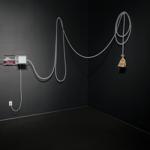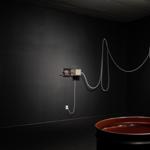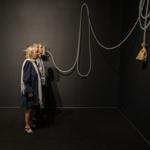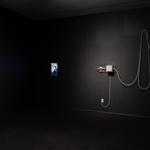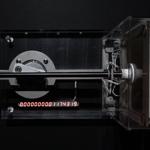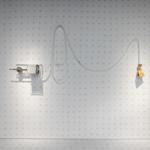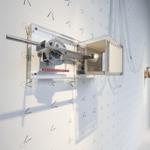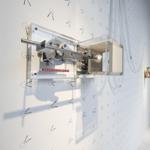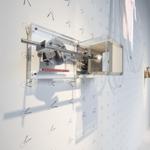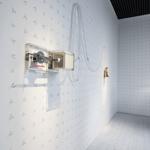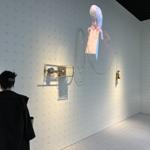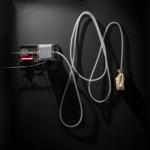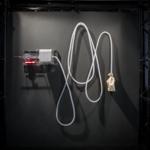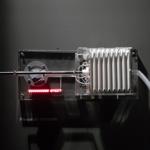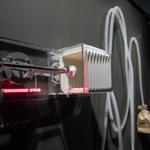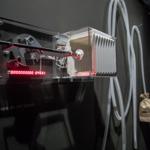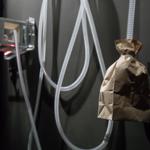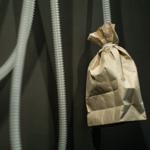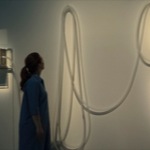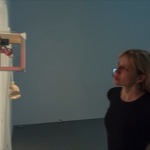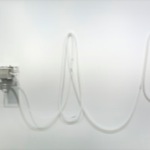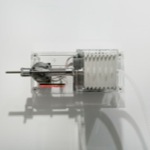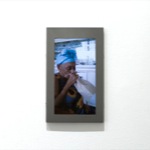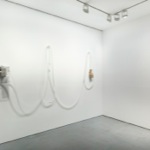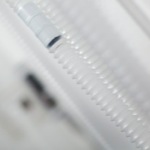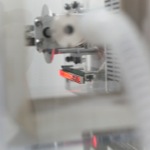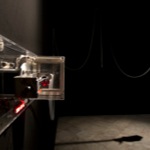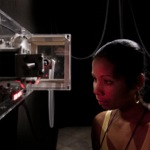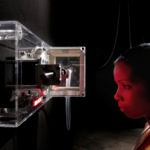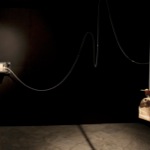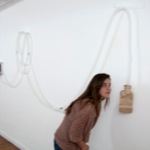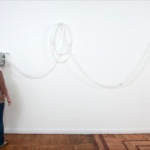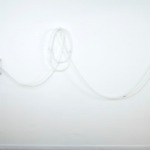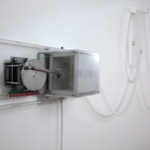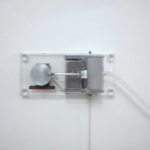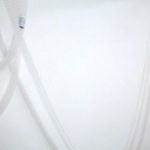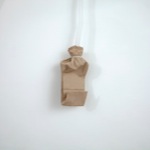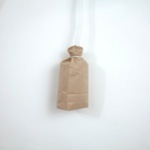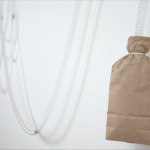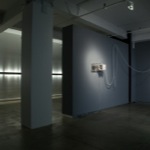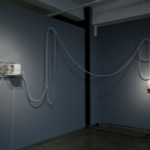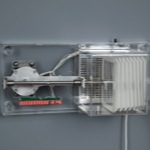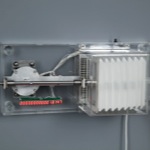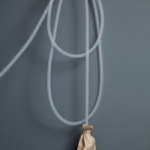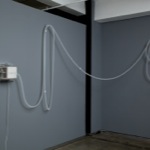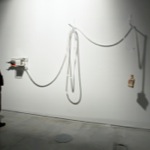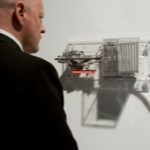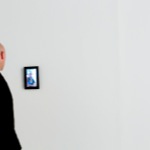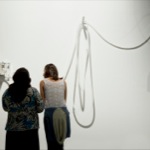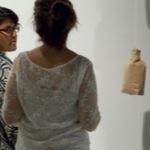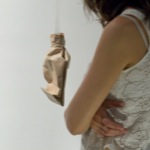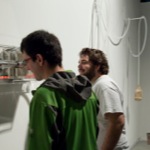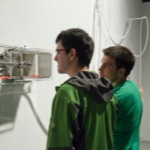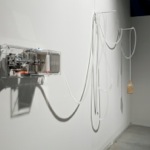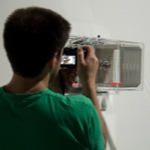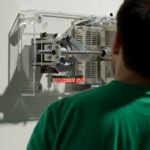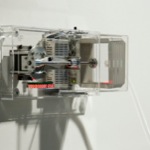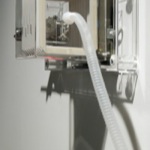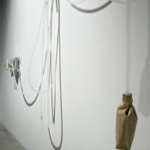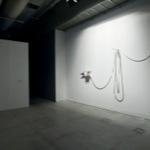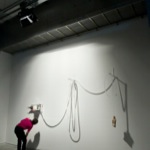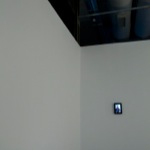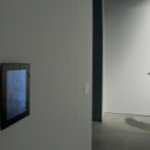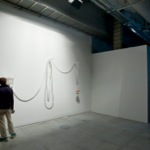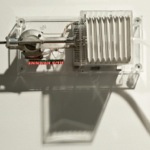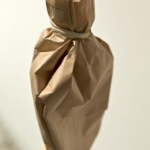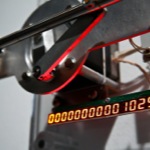Last Breath
“Last Breath” is an installation designed to store and circulate the breath of a person forever. The piece consists of a small brown paper bag which inflates and deflates automatically thanks to motorized bellows similar to those found in artificial respirators in hospitals. The apparatus hangs on a wall and is activated 10,000 times a day, the typical respiratory frequency for an adult at rest, including 158 sighs. Each stroke of the machine advances a digital counter that beeps. The breath circulates between the bellows and the paper bag through a ribbed transparent plastic tube that emits a faint and hypnotic low sound. The tube can be as large as necessary to either hang the bag right beside the piece, on the same wall, or to create a labyrinth on the ceiling of the exhibition that ends with the bag suspended in the middle of the room. The brown paper bag makes a rhythmic crushing sound as it inflates and deflates. As a biometric portrait, the piece requires careful curation, and the question of who gets stored should be in itself an interesting debate. The portrait should work as a living memorial of a senior respected artist, ideally a poet, singer or dancer. A small video of the person blowing into the bag is exhibited beside the apparatus.
The first copy of the piece stores the breath of Cuban singer Omara Portuondo. The piece is currently on tour but eventually will be exhibited by the National Museum of Music in Cuba: after she dies people will be able to visit her "Last Breath" there. The second copy of the piece has the last breath of American Avant-Garde composer and accordionist Pauline Oliveros, developer of the concept of “Deep Listening.” Oliveros died on Nov 24, 2016, but her breath continues circulating in this biometric portrait. The third copy is owned by Musée des Beaux-Arts de Montréal which stores French Canadian writer and poet Nicole Brossard’s breath. The fourth copy stores the breath of Finnish actor Seela Sella, owned by the EMMA Museum. The breath of Ecuadorian writer and poet Efrain Jara ldrovo was stored for the Bienal de Cuenca. The sixth copy stores the breath of Nigerian writer and poet Wole Soyinka.
Frequently asked questions:
1: Whose breath is stored?
Whoever the collector or curator wants, in discussion with the artist and the subject. It is possible to also have two people blow into the same bag, thus preserving their mixed breath.
2. How long will the project work for?
The mechanism will need light maintenance after a long period of continuous operation. The maintenance includes changing the brown paper bag and greasing the mechanism, simple tasks explained in the piece's manual. During maintenance, the piece stores the breath in the bellows so that it does not escape.
3. Can the breath be changed in the future?
Yes, if the collector or curator no longer wants to store the breath, he or she can refill the bag with the breath of a new person. Simple instructions to accomplish this are explained in the manual. The symbolic implications of this exchange should be carefully considered.
4. Is there a way to silence the piece?
The quiet sound generated by this piece is an integral part of the work. One may, however, unplug the piece from the wall to turn it off and silence it (the breath will be retained and the counter will not be reset).
5. Is there a preferred installation configuration?
The apparatus should be hung on a wall with a 150 cm-high centre. Other than that the collector or curator may do as they please with the tube, keep it all short and rolled on the same wall as the piece, extend it over the same wall as the piece, or hang it from the ceiling.
The first copy of the piece stores the breath of Cuban singer Omara Portuondo. The piece is currently on tour but eventually will be exhibited by the National Museum of Music in Cuba: after she dies people will be able to visit her "Last Breath" there. The second copy of the piece has the last breath of American Avant-Garde composer and accordionist Pauline Oliveros, developer of the concept of “Deep Listening.” Oliveros died on Nov 24, 2016, but her breath continues circulating in this biometric portrait. The third copy is owned by Musée des Beaux-Arts de Montréal which stores French Canadian writer and poet Nicole Brossard’s breath. The fourth copy stores the breath of Finnish actor Seela Sella, owned by the EMMA Museum. The breath of Ecuadorian writer and poet Efrain Jara ldrovo was stored for the Bienal de Cuenca. The sixth copy stores the breath of Nigerian writer and poet Wole Soyinka.
Frequently asked questions:
1: Whose breath is stored?
Whoever the collector or curator wants, in discussion with the artist and the subject. It is possible to also have two people blow into the same bag, thus preserving their mixed breath.
2. How long will the project work for?
The mechanism will need light maintenance after a long period of continuous operation. The maintenance includes changing the brown paper bag and greasing the mechanism, simple tasks explained in the piece's manual. During maintenance, the piece stores the breath in the bellows so that it does not escape.
3. Can the breath be changed in the future?
Yes, if the collector or curator no longer wants to store the breath, he or she can refill the bag with the breath of a new person. Simple instructions to accomplish this are explained in the manual. The symbolic implications of this exchange should be carefully considered.
4. Is there a way to silence the piece?
The quiet sound generated by this piece is an integral part of the work. One may, however, unplug the piece from the wall to turn it off and silence it (the breath will be retained and the counter will not be reset).
5. Is there a preferred installation configuration?
The apparatus should be hung on a wall with a 150 cm-high centre. Other than that the collector or curator may do as they please with the tube, keep it all short and rolled on the same wall as the piece, extend it over the same wall as the piece, or hang it from the ceiling.
General info
Spanish name:
Último Suspiro
Year of creation:
2012
Technique:
Motor, bellows, acrylic, digital display, custom circuitry, arduino processor, respiration tubing, brown paper bag, and video documentary
Dimensions:
Apparatus is approximately 60 x 26 x 26 cm when contracted, tube up to 17 m long
Weight:
Depending on the edition, varies from 8 to 13 kg
Edition:
6 Editions, 3 AP
Collectors:
Fondation Giverny pour l’art contemporain, Musée des beaux-arts de Montréal, San Francisco Museum of Modern Art and private collectors
Exhibitions
- Rafael Lozano-Hemmer: Obra Sonora, Artis - Naples, The Baker Museum, Naples, Florida, United States, 2024 - 2025.
- Atmospheric Memory, Manchester International Festival, Powerhouse Ultimo - Museum of Applied Arts and Science, Sydney, Australia, 2023.
- EMMA Talks: Rafael Lozano-Hemmer & Seela Sella, Espoo Museum of Modern Art, Espoo, Finland, 2022.
- In Search of the Present, Espoo Museum of Modern Art, Espoo, Finland, 2022 - 2023.
- Rafael Lozano-Hemmer: Atmospheric Memory, Manchester International Festival, University of North Carolina, Chapel Hill, North Carolina, United States, 2021.
- How long does it take for one voice to reach another? Conversation: Rafael Lozano-Hemmer, Nicole Brossard, and Mary-Dailey Desmarais, Musée des beaux-arts de Montréal, Montréal, Québec, Canada, 2021.
- How long does it take for one voice to reach another?, Musée des beaux-arts de Montréal, Montréal, Québec, Canada, 2021 - 2022.
- Rafael Lozano-Hemmer: Atmospheric Memory, Manchester International Festival, Manchester, United Kingdom, 2019.
- Rafael Lozano-Hemmer: Decision Forest, Amorepacific Museum of Art, Seoul, South Korea, 2018.
- Corpus, New Media Gallery, New Westminster, British Columbia, Canada, 2018.
- Soundtracks, San Francisco Museum of Modern Art, San Francisco, California, United States, 2017 - 2018.
- XIII Bienal de Cuenca, Bienal de Cuenca, Museo de las Madres Conceptas & Museo de la Medicina, Cuenca, Ecuador, 2016 - 2017.
- The Governor General's Awards in Visual and Media Arts 2015, National Gallery of Canada, Ottawa, Ontario, Canada, 2015.
- Rafael Lozano-Hemmer: Obra Sonora, Carroll / Fletcher Gallery, London, United Kingdom, 2014.
- 1 + 1 = 1, Musée des beaux-arts de Montréal, Montréal, Québec, Canada, 2014.
- 0 to 60: The Experience of Time through Contemporary Art, Pratt Manhattan Gallery, New York City, New York, United States, 2013 - 2014.
- 0 to 60: The Experience of Time through Contemporary Art, North Carolina Museum of Art, Raleigh, North Carolina, United States, 2013.
- Volume: Hear Here, Justina M. Barnicke Gallery, Toronto, Ontario, Canada, 2013.
- Rafael Lozano-Hemmer: Trackers, Fundación Telefónica, Buenos Aires, Argentina, 2012.
- Expo Chicago 2012, Navy Pier, Galería Max Estrella, Chicago, Illinois, United States, 2012.
- Rafael Lozano-Hemmer: Voice Array, bitforms gallery, New York City, New York, United States, 2012.
- Art Basel 43, Galería OMR, Basel, Switzerland, 2012.
- 11th Edition: Artistic Practices and Social Imaginaries, Bienal de la Habana, Havana, Cuba, 2012.
- Rafael Lozano-Hemmer: X no es la nueva Y, Galería OMR, Mexico City, México, 2012.
Credits
- Programming: David St-Onge, Pipo Pierre-Louis, Lauria Clarke
- Hardware: David St-Onge, Pipo Pierre-Louis, William Sutton
- Production Assistance: Guillaume Tremblay, Pierre Fournier, Sebastien Dallaire
Bibliography
- "Rafael Lozano-Hemmer (Canadá-México)." XIII Bienal de Cuenca, 2016. Cuenca, Ecuador, 2017. (español) (Websites)
- "Rafael Lozano-Hemmer PG." Prepared Guitar, 13 Jan. 2015. Madrid, Spain, 2015. (english) (Websites)
- "Rafael Lozano-Hemmer: Obra Sonora." Digicult, 26 Sep. 2014. Milan, Italy, 2015. (Websites)
- Ávila, Sonia. "Latidos de luz con espiral lumínica." Excelsior, 11 Apr. 2012. Mexico City, México, 2013. (español) (Newspapers)
- Benson, Louis. "Speakers as Pixels." Postmatter, 3 Oct. 2014. London, United Kingdom, 2014. (english) (Websites)
- Campbell-Dollaghan, Kelsey. "A Digital Artist Combines Ghostly Light Shows And Beatboxing." Fast Co Deisgn, 2013. United States, 2013. (english) (Websites)
- Fortin, Sylvie. "Artists Reclaim the Commons: New Works / New Territories / New Publics." ISC Press, 2013. Hamilton, New Jersey, United States. (english) (Books)
- Freeland, Anna. "Rafael Lozano-Hemmer’s Atmospheric Memory headlines Science Week at the Powerhouse with epic interactive exhibit for existential reflection." ABC News, 19 Aug. 2023. 2023. (english) (Newspapers)
 Gorman, Alyx. "‘There’s no such thing as a neutral algorithm’: the existential AI exhibition confronting Sydney." The Guardian, 13 Aug. 2023. 2023. (english) (Newspapers)
Gorman, Alyx. "‘There’s no such thing as a neutral algorithm’: the existential AI exhibition confronting Sydney." The Guardian, 13 Aug. 2023. 2023. (english) (Newspapers)- Hajdin, Nives. "Sound Artists Raise the Volume at U of T." Canadian Art, 25 Jan. 2013. Toronto, Ontario, Canada, 2013. (english) (Magazines)
 Lewandowska Cummings, Basia. "Rafael Lozano-Hemmer. Carroll/Fletcher, London." Frieze Magazine, 1 Jan. 2015. London, United Kingdom, 2015. (english) (Magazines)
Lewandowska Cummings, Basia. "Rafael Lozano-Hemmer. Carroll/Fletcher, London." Frieze Magazine, 1 Jan. 2015. London, United Kingdom, 2015. (english) (Magazines)- Mallol, Miguel. "Las obras de Rafael Lozano Hemmer llegan a la Galería Carroll & Fletcher." El Ibérico, 13 Oct. 2014. London, United Kingdom, 2015. (español) (Newspapers)
- Martínez Martínez, Juan. "La tecnología también se vive desde el arte." Vanguardia, 29 Oct. 2014. Bucaramanga, Colombia, 2014. (español) (Newspapers)
- Rae, Marion. "‘Enchantress of numbers’ opens atmospheric exhibition." The West Australian, 21 Oct. 2023. Australia, 2023. (english) (Newspapers)
- Revuelta, Laura. "Ultimo aliento en la bienal de la habana." ABC.es, 21 May 2012. Havana, Cuba, 2013. (español) (Newspapers)
- Rojas Torres, Jesus Manuel. "WUM News London: Obra Sonora, Rafael Lozano-Hemmer's debut at Carroll/Fletcher." WUM An online journal for the arts, 16 Oct. 2014. Miami, Florida, United States, 2015. (english) (Websites)
- Simpson, Peter. "Big statements and tiny provocations, in Governor General's Awards for visual arts at National Gallery." Ottawa Citizen, 9 Apr. 2015. Ottawa, Ontario, Canada, 2015. (english) (Newspapers)
- Suárez, Eunice. "Rafael Lozano-Hemmer transformó el arte contemporáneo." Fahrenheit, 5 June 2015. Mexico City, México, 2015. (español) (Magazines)
- Susik, Abigail. "The perpetration of the cultural act." Media-N Journal of the NMC, Sep. 2014. New York City, New York, United States, 2015. (english) (Magazines)
- Villalobos, Gabriel. "Intersticios entre arte y arquitectura." Arquine, 2 May 2012. Mexico City, México, 2013. (español) (Magazines)
- Westbrook, Lindsey. "Team media: in action, in contemplation." SFMOMA, 2016. San Francisco, California, United States, 2016. (english) (Websites)
Photo Library (click to expand)
